The Last Supper, by Leonardo da Vinci: analysis and meaning of painting (with images)
The Last Supper (Il cenacolo) is a wall painting made between 1495 and 1498 by the multifaceted Leonardo da Vinci (1452-1519). It was commissioned by Ludovico Sforza for the refectory of the Convent of Santa Maria delle Grazie in Milan, Italy. Leonardo did not charge for it. The scene recreates the last Passover supper between Jesus and his apostles, based on the story described in the Gospel of John, chapter 13.

Fresco analysis The Last Supper by Leonardo da Vinci
Ernst Gombrich says that in this work Leonardo was not afraid to make the necessary drawing corrections to give it total naturalism and verisimilitude, something little seen in the preceding mural painting, characterized by deliberately sacrificing the correctness of the drawing based on other elements. That was precisely the intention of Leonardo when mixing tempera and oil for this work.
In his version of the Last Supper, Leonardo wanted to show the exact moment of the disciples' reaction when Jesus announced the betrayal of one of those present (Jn 13: 21-31). The shock is noticeable in the painting thanks to the dynamism of the characters who, instead of remaining inert, react energetically to the advertisement.
Leonardo introduces for the first time in the art of this type a great drama and tension between the characters, something unusual. This does not prevent him from achieving that the composition enjoys great harmony, serenity and balance, thus preserving the aesthetic values of the Renaissance.
The characters of The Last Supper
On Leonardo da Vinci's notebooks the characters are identified, who appear grouped in trios except for Jesus. From left to right they are:
- First group: Bartolomeo, Santiago el Menor and Andrés.
- Second group: Judas Iscariot, Pedro and Juan, called "the beardless one".
- Central character: Jesus.
- Third group: Tomás, Santiago el Mayor indignant and Felipe.
- Fourth group: Mateo, Judas Tadeo and Simón.
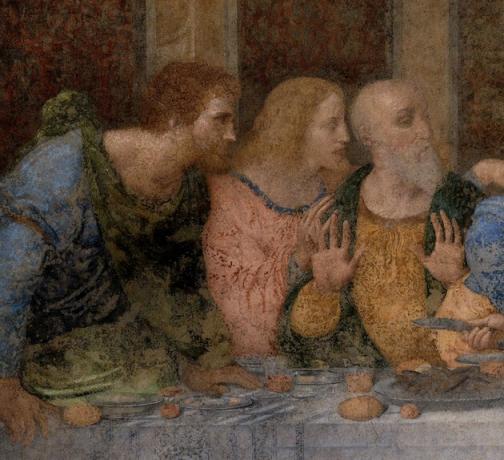
It highlights the fact that Judas, unlike the iconographic tradition, is not separate from the group, but is integrated among the diners, in the same group as Pedro and Juan. With this, Leonardo introduces an innovation in the fresco that puts it at the center of the artistic references of his time.
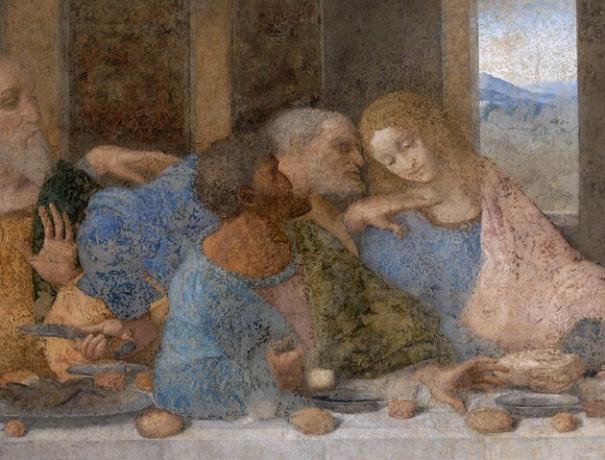
In addition, Leonardo manages to give a really different treatment to each of the characters on stage. Thus, he does not generalize the representation of them in a single type, but each one is endowed with its own physical and psychological traits.
Also surprising is the fact that Leonardo places a knife in Peter's hands, alluding to what will happen shortly after the arrest of Christ. With this, Leonardo manages to delve into the psychology of the character of Peter, undoubtedly one of the most radical apostles.
See also The passion of Jesus in art.
Perspective of The Last Supper
Leonardo uses vanishing point perspective or linear perspective, characteristic of Renaissance art. The main focus of his perspective will be Jesus, the reference center of the composition. Despite the fact that all the points converge on Jesus, his open and expansive position with outstretched arms and calm gaze contrasts and balances the work.
Leonardo's particular use of vanishing point perspective, combined with the representation of a space classical architectural style, create the illusion that the refectory space is expanded to include such important diners. It is part of the illusionist effect achieved thanks to the principle of verisimilitude.
The lighting

One of the elements typical of the Renaissance was the use of the window system, to which Leonardo used a lot. These allowed to introduce, on the one hand, a source of natural light, and on the other, spatial depth. Pierre Francastel referred to these windows as an anticipation of what the "veduta", that is, the sight from the landscape.
Fresco lighting The Last Supper it comes from the three windows at the back. Behind Jesus, a larger window opens the space, also demarcating the importance of the protagonist of the scene. In this way, Leonardo also avoids the use of the halo of holiness that was normally arranged around the head of Jesus or the saints.
The philosophical approach
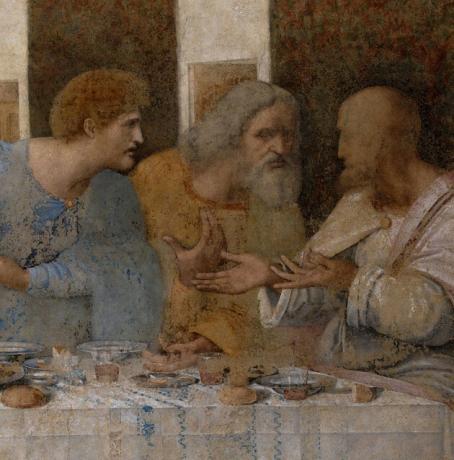
Leonardo da Vinci understood painting as a science, since it implied the construction of knowledge: philosophy, geometry, anatomy and more were disciplines that Leonardo applied in painting. The artist was not limited to merely imitating reality or constructing a principle of verisimilitude out of sheer formalism. On the contrary, behind each work of Leonardo there was a more rigorous approach.

According to some researchers, Leonardo would have reflected in the fresco of The Last Supper his philosophical conception of the so-called Platonic triad, highly valued in those years. The Platonic triad would be shaped by the values of the Truth, the Goodness and the Beauty, following the line of the Florentine Platonic Academy, Ficino and Mirandola. This school of thought defended Neoplatonism in opposition to Aristotelianism, and sought to find a reconciliation of Christian doctrine with Plato's philosophy.
The Platonic triad is represented in some way in three of the four groups of characters, since the group where Judas is would be a break. Therefore, it is presumed that the group located at the extreme right of the fresco could be the representation of Plato, Ficino and the self-portrayed Leonardo himself, who have a discussion on truth of Christ.
The third group, on the other hand, would be interpreted by some scholars as an evocation of platonic love that seeks beauty. This group could represent the Holy Trinity at the same time due to the apostles' gestures. Thomas points to the Most High, James the Greater extends his arms as if evoking the body of Christ in the cross and, finally, Philip brings his hands to his chest, as a sign of the interior presence of the Spirit Holy.
State of conservation
The play The Last Supper it has deteriorated over the years. In fact, the deterioration began a few months after it was completed. This is a consequence of the materials used by Leonardo. The artist took his time to work, and the fresco technique did not suit him as it required speed and did not allow repainting, since the plaster surface dried very quickly. Therefore, in order not to sacrifice the mastery of the execution, Leonardo devised to mix oil with tempera.
However, because the plaster does not adequately absorb the oil paint, the process of deterioration of the fresco began very soon, which has led to numerous restoration attempts. To date, much of the area has been lost.
See also:
- Mona Lisa painting by Leonardo da Vinci.
- The 25 most representative paintings of the Renaissance
Copies of The Last Supper by Leonardo da Vinci
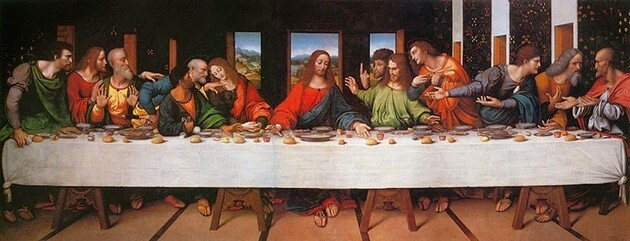
Numerous have been the copies that have been made of The Last Supper by Leonardo, which speaks for itself of the influence of this piece on Western art. The oldest and most recognized belongs to Giampetrino, who was a disciple of Leonardo. It is believed that this work rebuilds the original appearance to a greater extent, since it was made very close to the completion date, before the damage was evident. The work was in the custody of the Royal Academy of Arts in London, and was delivered to Magdalen College, Oxford, where it is currently located.
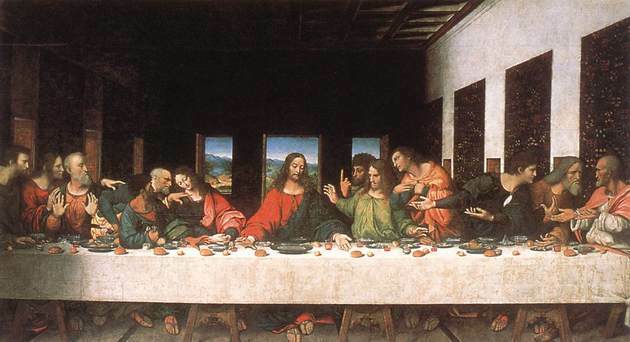
This copy is added to those already known, such as the version attributed to Marco d'Oggiono, exhibited in the Renaissance Museum of the Castle of Ecouen; that of the Abbey of Tongerlo (Belgium) or that of the church of Ponte Capriasca (Italy), among many others.

In recent years a new copy has also been found in the Saracena Monastery, a religious building that can only be reached on foot. It was founded in 1588 and was closed in 1915, after which it was temporarily used as a prison. The discovery is not so recent in reality, but its diffusion in the cultural tourism market.
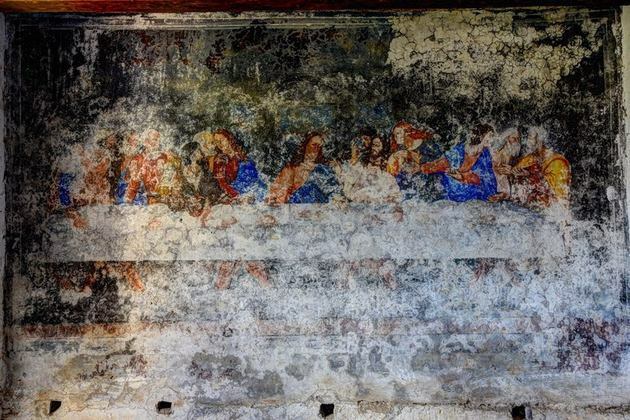
The Last Supper of Leonardo da Vinci in fiction literature
The Last Supper It is one of the most famous works of the Renaissance and, along with the Mona Lisa, it is undoubtedly Leonardo's best-known work, a figure around which speculation does not cease. For this reason, over time Leonardo's work has been attributed a secret and mysterious character.
Interest in the supposed mysteries of the fresco was on the rise after the publication of the book The Da Vinci Code in 2003 and the premiere of the homonymous film in 2006. In this novel Dan Brown supposedly reveals several secret messages that Leonardo would have captured in the fresco. However, experts point out that the novel is riddled with historical and artistic errors.
Brown's novel is based on the hypothesis that Jesus and Magdalene had offspring, an unoriginal argument, and their descendant today would be the true Holy Grail who would have to be protected from the ecclesiastical power that he wanted hide him. Brown is based on reading The sacred enigma or The Holy Bible and the Holy Grail, where it is held that San Gréal it would mean 'royal blood', and it would refer to a royal lineage and not to an object.
To justify the argument, Brown uses Leonardo's fresco of the Last Supper, in which glasses of wine abound but there is no chalice itself, so that he tries to find a mystery in it: why would there not be a chalice as in all other paintings on the theme? This leads him to analyze the other elements of the fresco in search of a "code". This is how the leading character in the novel concludes that Juan is, in fact, María Magdalena.



